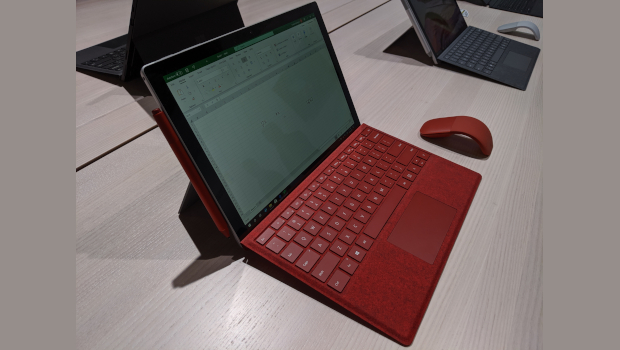
Hands on: Microsoft Surface Pro 7 – Ice Lake promise
Most of the improvements in Microsoft’s Surface Pro 7 are tied to an Intel “Ice Lake” microprocessor upgrade, and that is not necessarily a bad thing.
Admittedly, we have dinged prior Surface tablets like the Microsoft Surface Pro 6 because they have largely remained static over the past few generations. We cannot quite say the same for the Surface Pro 7, for two reasons: One is that chip, and the other is the addition of a more modern USB-C port.
Microsoft’s Surface Pro 7 starts at $749 (Irish pricing not yet available, but is usually dollar price in euros), and is available in either black or platinum. (The existing Type Covers have several different colour options, including black and the red colour shown here.) That price can quickly climb to $2,299, though, with higher-end options. A corporate version running Windows 10 Pro is also available.

Here are more details about the primary specs:
- Display: 312 mm (12.3-inch) (2736×1824) (267ppi) touch PixelSense display
- Processor: Core i3-1005G1/Core i5-1035G4/Core i7-1065G7
- Graphics: UHD Graphics (Core i3); Iris Plus (Core i5, Core i7)
- Memory: 4GB/8GB/16GB 3,733MHz LPDDR4x
- Storage: 128GB/256GB/512GB/1TB SSD
- Ports: Surface Connect, USB-A, USB-C, miniDisplayPort, microSD
- Camera: 5MP (user-facing)/Full HD with Windows Hello; 8MP (rear) with
1080p video - Battery: 10.5 hours (estimated); quick-charge to 80% in an hour
- Wireless: Wi-Fi 5 (802.11ax)/Bluetooth 5.0
- Operating system: Windows 10 Home (consumer) / Windows 10 Pro (business)
- Dimensions: 11.5 x 7.9 x 0.33 inches (7.3mm)
- Weight: 1.70-1.73 pounds, depending upon the processor
- Colour: Black, Platinum
- Price: Pre-orders start at $749 at Microsoft.com
If you are familiar with the Surface line-up, you are familiar with the Surface Pro 7. Behind it is the familiar kickstand, which still reclines to 165 degrees. The optional Type Cover and Surface Pen are still here, too.
The USB-C port is a change that looks to the future. In the new Surface Laptop 3, for example, the miniDisplayPort port was removed and replaced with USB-C. On the older Surface Pro 6, USB-C was added to the mix of ports, which still includes the miniDisplayPort. (That was somewhat of an odd choice, if only because the Surface Pro tablet has less physical volume to play with than the Surface Laptop. But who knows?)
Microsoft is also touting the dual far-field stereo mics. They figure into the enhancements Microsoft is making to digital assistants within Windows, such as placing them on the lock screen in the upcoming “19H2” release of Windows 10. These were not tested.
Internally, the addition of the Intel Ice Lake processor is the most meaningful upgrade. Recall that the Surface Pro 6 was built upon Intel’s Kaby Lake-R chip, which is now two generations removed. Ice Lake itself does not apparently offer much of a performance uptick, but the Iris Plus graphics does, to the tune of 40% in our Ice Lake preview.
Note that Iris Plus is not available in the Core i3 variant of the Surface Pro 7, which could rule out that configuration for power users. The Core i3 and Core i5 versions continue to be fanless, like previous models, while the Core i7 model has a fan that will turn on “intermittently,” we’re told. (We tried to force the fan on in our demo model, but we couldn’t hear it over the ruckus of a rowdy demo room.) A fanless Core i5 could be a sweet spot — or it could mean that the Core i5 thermally throttles itself under load. At this point, we just don’t know.
Simply put, though, the Surface Pro 7 holds few secrets. It is still a comfortable tablet to use on a desktop, less so on your lap — the Surface Laptop 3 is the better bet there. Otherwise, what makes the Surface Pro 7 attractive is what is inside it.
Mark Hachman is senior editor for PC World
IDG News Service








Subscribers 0
Fans 0
Followers 0
Followers